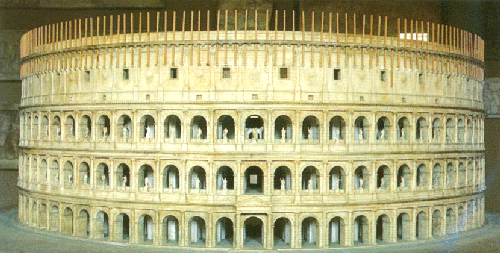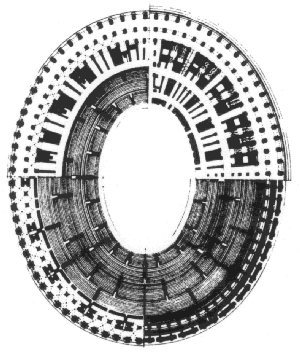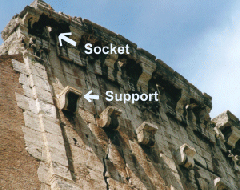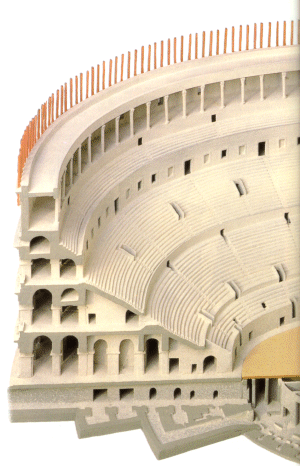
ARCHITECTVRA

Description
The Colosseum is elliptical in
shape, with its long axis, oriented WSW-ESE, which measures 188 m and
the short one 156. The building stands on a base of two steps; above it there are
three floors of arcades built in travertine stone and a fourth storey with windows. There
were eighty arches on every floor, divided by pillars with a half column. 

The four arches on the axes of the building were the main entrances, and were probably decorated with a little porch and a statue. The other 76 arches were numbered for an easier access to the seats (32 arches of the outer ring, from number XXIII to LIV have remained intact.
The ground floor half columns are doric in style, those of the second floor are ionic and those of the upper floor Corinthian. The attic is divided into panels by Corinthian columns, with a rectangular window every second panel. Ancient authors mention a series of bronze shields (clipea) affixed all around the attic.
The arches are 4.20 m. (13’9") wide and 7.05 m (23’1") high on the ground floor, while on the upper floors they are only 6.45 m (21’2") high. Including the cornices between the floors and the attic, the overall height of the building is 48,5 m.
The arena, in which took place the gladiatorial combats (ludi gladiatori) and with the
wild beasts, measured 75 m by 44 and it was made of wood,
covered with yellow sand taken from the hill of Monte Mario. Over 100.000 cubic metres of travertine stone (45.000 only for the external
wall), quarried near Tibur (today Tivoli), were employed for the building. A road was
built from the quarries to Rome for this purpose. Tufa blocks, bricks and opus cementicium (concrete made of small lumps of tufa
in mortar) were also employed, thus adapting the resistance of the materials to the loads
and thrust that had to be supported. The combination of different materials improves the elasticity of the whole: the main
pillars are made of travertine, radial walls are of travertine and tufa, the vaults are
cast in cementwork, and the walls were plastered and painted white and red (most of the
stuccoes have disappeared). The passages corresponding to the main entrances were
decorated with paintings and stuccoes, which have hardly survived the centuries.
All around the top there were the sockets for 240 wooden beams which supported the awning (velarium) that covered the spectators from the sun and was manoeuvred by a unit of sailors of the imperial fleet, stationed nearby.
The Colosseum was surrounded by an area paved with large travertine slabs and delimited by boundary stones set in the ground with a slight inclination inwards, which are supposed to have been supports of some sort for the ropes of the awning (Some others think that they were some sort of gates for crowd control). Beyond these stones began the street paving of big gray blocks of basaltic lava.
What is left of the original building? The north side of the
outer wall is still standing, comprising 31 arches of the original 80, with that part of
the building which is between it and the inner wall supporting the colonnade, and
practically the whole skeleton of the structure between this inner wall and the arena,
that is, the encircling and radiating walls on which rested the cavea with its
marble seats, that have disappeared.
The seating was all in travertine, now almost completely lost (the section in the picture was reconstructed in the 30s), and was raised 3.60 m above the arena. Part of the floor of the arena was made of masonry and part of wood, with removable sections for the entrance/exit of scenarios, beasts and materials. There were marble decorations around the podium, at the vomitoria that gave on the cavea for the passage of people, and perhaps on the niches beside the main entrances on the arena.
Under the arena there were all the services necessary for the shows: cages for the animals, stores, tools, and the lifts that raised the beasts to trapdoors placed on the floor of the arena. When wild beasts were in the amphitheatre a fence was erected all around the podium. The fence had wooden rollers on top, in order to prevent the beasts from climbing over. Inside, the seating has a gradient of 37°, and the overall height of 48.5 m (159’) was calculated to give a good view of the arena even to the spectators in the upper seats.
A section of the cavea
The corridors and stairs were planned in order to allow the public, calculated between 50.000 and 75.000, swift access and exit and to keep the different classes of spectators separated. The two main entrances on the short axis led directly to the central boxes, while a series of obligatory pathways, symmetrically repeated in each quadrant of the stand, led the other spectators to their assigned places.
Between the arena and the wall surrounding it, called podium, there was a service tunnel, with niches. Their function is uncertain; some say they housed archers who protected the spectators from the risk of wild animals reaching the public, some say they were latrines, and some say that there was a water channel meant to give supplementary protection from the beasts. In any case, it seems that these niches could be reached only through some entrances located in the fourth ring of the cavea, accessible only to service personnel. Another mystery of the Colosseum...
Click here for the next of a series of pages about the construction